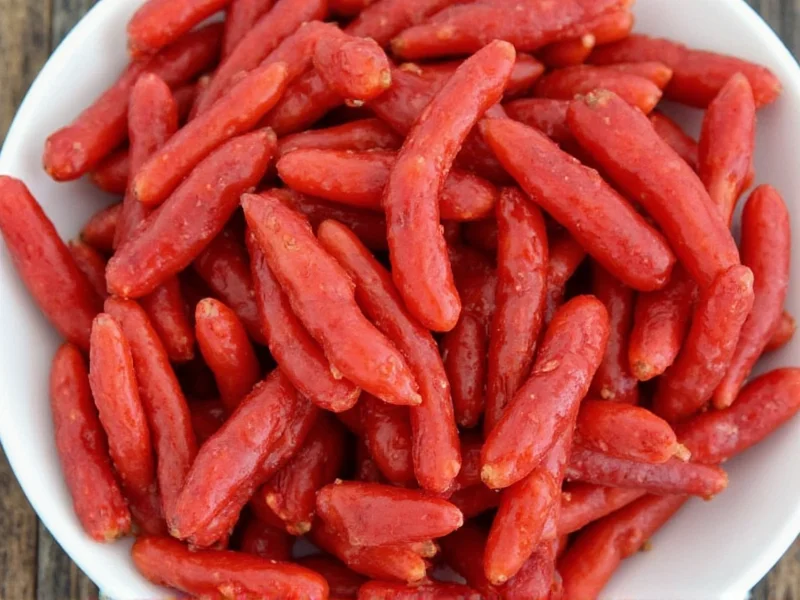Chamoy, that vibrant Mexican condiment known for its perfect balance of sweet, sour, salty, and spicy flavors, has become increasingly popular worldwide. Whether you've just discovered this delicious sauce or have had a bottle sitting in your pantry for months, understanding its shelf life is essential for both flavor quality and food safety. This comprehensive guide provides evidence-based information about chamoy's longevity under various storage conditions.
Understanding Chamoy Composition and Preservation
Chamoy's shelf life depends significantly on its ingredients and preservation methods. Traditional chamoy starts with pickled fruit (often apricots, plums, or mangoes) preserved in a brine solution containing salt and vinegar. The pickling process creates an acidic environment that naturally inhibits bacterial growth. Commercial varieties typically include additional preservatives like sodium benzoate or potassium sorbate, which significantly extend shelf life compared to homemade versions.
The sugar content in chamoy also plays a crucial preservation role. Higher sugar concentrations create an osmotic environment where microorganisms struggle to survive. This explains why thicker chamoy pastes often last longer than thinner sauces with lower sugar content.
Unopened Chamoy Shelf Life Explained
When properly sealed in factory packaging, commercial chamoy benefits from industrial preservation techniques that maximize longevity. The "best by" date on commercial chamoy products typically indicates 12-24 months from production, though the product often remains safe beyond this date if unopened and stored correctly.
| Chamoy Type | Unopened Shelf Life | Storage Conditions |
|---|---|---|
| Commercial liquid chamoy | 18-24 months | Cool, dark pantry (below 75°F/24°C) |
| Commercial chamoy paste | 24-30 months | Cool, dark pantry (below 75°F/24°C) |
| Homemade chamoy | 3-6 months | Refrigerated immediately after preparation |
Temperature stability significantly impacts unopened chamoy's longevity. Products stored in consistently cool environments (below 75°F/24°C) maintain quality longer than those exposed to temperature fluctuations. Avoid storing chamoy near heat sources like stoves or in direct sunlight, as this accelerates ingredient breakdown and preservative degradation.
Post-Opening Shelf Life and Storage Best Practices
Once you break the seal on commercial chamoy, its shelf life decreases substantially. Proper post-opening storage becomes critical for maintaining both safety and flavor quality. The moment air enters the container, oxidation begins affecting the product's color, texture, and taste.
Refrigeration is non-negotiable after opening. Transfer opened chamoy to an airtight glass or food-grade plastic container if it didn't come in a resealable bottle. Ensure the container is completely dry before transferring the product, as moisture introduces bacteria that accelerate spoilage.
When handling chamoy, always use clean utensils. Introducing contaminants through double-dipping or dirty spoons significantly reduces shelf life. For frequent users, consider dividing larger containers into smaller portions to minimize repeated exposure to air and potential contaminants.
Homemade Chamoy: Special Storage Considerations
Homemade chamoy lacks the industrial preservatives found in commercial products, resulting in a much shorter shelf life. Without proper acidification and preservation techniques, homemade versions typically last only 4-6 weeks refrigerated. The exact duration depends on several factors:
- Vinegar concentration: Higher acidity extends shelf life
- Sugar content: More sugar creates a less hospitable environment for bacteria
- Initial fruit quality: Fresh, undamaged fruit yields longer-lasting product
- Processing temperature: Proper heating during preparation kills more microorganisms
For those making chamoy at home, consider adding citric acid to achieve a pH below 4.6, which prevents botulism growth. Always process homemade chamoy in sterilized containers using proper canning techniques if you want to extend shelf life beyond refrigeration.
Identifying Spoiled Chamoy: Safety First
Recognizing when chamoy has spoiled is crucial for food safety. While chamoy's high acidity and sugar content make it relatively resistant to spoilage, it's not immune. Watch for these definitive signs that your chamoy has gone bad:
- Visible mold: Any fuzzy growth, even in small amounts, means immediate disposal
- Off odors: Sour or alcoholic smells beyond the product's normal tang
- Texture changes: Excessive separation that doesn't remix with stirring
- Color shifts: Significant darkening or unusual discoloration
- Bulging container: Indicates gas production from microbial activity
When in doubt, throw it out. Consuming spoiled chamoy could lead to foodborne illness, particularly for those with compromised immune systems. Remember that "how long does chamoy last after opening" depends on proper storage—neglecting refrigeration dramatically shortens its safe consumption window.
Maximizing Chamoy's Freshness and Flavor
Several techniques can help extend your chamoy's prime condition. For opened bottles, consider these professional storage tips:
- Always keep the surface of the chamoy covered with a thin layer of oil to prevent oxidation
- Store containers upside down to create an additional air barrier
- Use clean, dry utensils every time you access the product
- Keep containers away from strong-smelling foods in the refrigerator
- Consider freezing small portions for long-term storage (up to 12 months)
Freezing chamoy requires special preparation. Portion it into ice cube trays, then transfer the frozen cubes to airtight freezer bags. This method allows you to thaw only what you need while keeping the remainder properly preserved. Frozen chamoy may experience slight texture changes but retains flavor integrity for culinary applications.
Chamoy Expiration Dates Decoded
Understanding the dates on commercial chamoy packaging prevents unnecessary waste. Most products display either a "best by," "use by," or "sell by" date, each with different implications:
- Best by date: Indicates peak quality period, not safety deadline
- Use by date: More critical for perishable items (less common for chamoy)
- Sell by date: Intended for retailers, not consumers
Commercially packaged chamoy often remains safe well beyond the printed date if unopened and properly stored. The "how long does chamoy last unopened" question typically has a positive answer for 6-12 months past the date, though flavor quality may gradually diminish.











 浙公网安备
33010002000092号
浙公网安备
33010002000092号 浙B2-20120091-4
浙B2-20120091-4